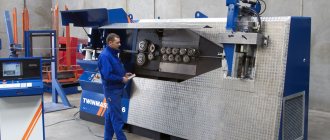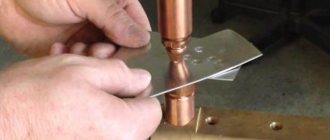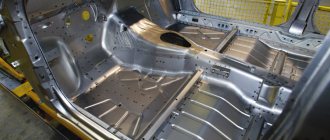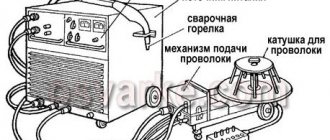The reinforcement consists of rods of different diameters, having a smooth and ribbed surface. Reinforcement is a popular structural element used in many fields.
This building material is used in the following industries:
- production of reinforced concrete structures of domestic and industrial profiles: foundations, load-bearing walls, floors and columns;
- construction of special hydraulic structures;
- construction of frames;
- production of metal mesh for various purposes;
- arrangement of pedestrian zones and road surfaces.
- creation of other important products.
The main advantages of fittings should be highlighted:
- simplicity and ease of use;
- high strength;
- high thermal conductivity coefficient;
- a wide selection of rods depending on diameter, section profile, principle of application, purpose, production method, etc.;
- durability of reinforcement structures.
ATTENTION! We immediately warn you that if what is said in this article contradicts what was said in the technical specifications you received for welding a critical structure, do as indicated in the project. This page contains information applicable to low-rise construction and the use of rebar in decorative products.
Welding features
The process of welding reinforcement has its own peculiarities: the welding seam during cross welding has a short length due to the small contact area; as a result of welding this material, a perpendicular connection occurs. This connection can form a kind of lever, the main load of which falls on the site of the weld.
These specific characteristics require a special approach. To do this, there are several ways to weld reinforcement. The correct choice of the necessary technology can reduce costs and guarantee high-quality results.
Content
- Definition, diagram and types of butt welding
- Resistance butt welding
- Flash butt welding
- The essence of the resistance butt welding process
- Heating the metal being welded
- Plastic deformation of metal
- Technological capabilities of butt welding
- Weldable materials and design requirements
- Preparation for welding
- Selecting welding mode parameters
- Treatment of joints after welding
- Welding machines
- Equipment control systems
- Devices and equipment
- Treatment of joints after welding
Resistance butt welding is a high-tech and, for the most part, automated method of joining parts. The share of flash butt welding is approximately 10% of all resistance welding used in practice. This welding method refers to electrothermodeformation processes, according to GOST 2601, but, unlike spot and seam resistance welding, the connection can be obtained using deep plastic deformation without melting the metal.
Methods
There are several methods for welding reinforcement. Each method is used depending on the specific situation and to solve certain problems.
Arc welding
Electric arc welding is used by specialists in the following situations:
- work with large diameter fittings;
- fastening of reinforcement from steels of different grades.
The welder should use electrodes whose composition is similar to the composition of the products being welded, as well as a welding transformer, inverter or other source of welding current.
The main advantage is the ability to use conventional welding equipment. The main disadvantage is that connections created by this method are not able to withstand increased loads . The technology of welding reinforcement using manual arc welding is used when installing frames, metal structures and meshes.
overlap
The next method is overlap welding, which is performed using one or two flank seams. In fact, this method can be characterized as joining reinforcement by welding, carried out in the longitudinal plane.
It should be noted that the greater the overlap of the reinforcement during welding, the greater the strength of the structure. It must be taken into account that welding is carried out on two opposite sides of the connection.
Sometimes this creates inconvenience during the procedure. For example, one weld is located on the top side of two work rods, and the other is located on the bottom. Thus, it is difficult or impossible to reach the second connection and the seam is unreliable. Therefore, this method can only be used in cases where the finished product will not be subjected to significant loads.
It is necessary to choose the correct diameter of the electrodes. Reinforcement with a diameter of 5-8 mm. It is cooked with a rod with a diameter of 3 mm. For 8-10 mm. You will need a 4mm consumable. Rods with a diameter of more than 10 mm. – electrodes with a diameter of 5 mm.
Important! This technology is not used for welding steel whose diameter exceeds 20 mm.
Bathtub butt
The butt welding method is used for butt welding of reinforcement. For this method, the performer will need a special device. The bath ( bracket-plate for welding reinforcement) serves as a barrier to the flow of molten metal. The essence of the process is that the ends of the reinforcement rods to be welded are located inside the bath. Then they are melted one by one using electrodes. The electrode should lightly touch the rod, since welding is carried out at high current values.
For materials with a diameter of 5-6 mm. a current of 400-450 A is used. Low temperatures help increase the current by another 10-15%. The deposited metal fills the bath and the two rods are fastened into one monolithic connection.
It should be noted that this method is the most preferable due to the minimal costs of welding materials and metal, as well as due to the production of strong and reliable structures. Another advantage of this method is the ability to work with large diameter fittings - 20-100 mm.
There are three types of staples, the division is carried out depending on the raw material. Steel forms are one-piece, i.e. the bath becomes part of the welded structure. Copper and graphite pads are removed from the joint after the work is completed. They can be reused later. Graphite molds must be calcined before use, as they easily absorb moisture.
What brands of electrodes are used to work with different types of fittings will be indicated below.
Welding techniques
Several technologies are used for welding reinforcement. The main techniques are bath welding of reinforcement, lap welding, creation of cross-shaped joints, contact technology. Below we will look at each technique in more detail.
Butt joint method
Bath welding of reinforcement is the optimal method for welding reinforcing bars. A pan is a U-shaped bracket to which steel rods will be welded. Bathroom technology allows you to obtain a high-quality, reliable seam that will not crack under the influence of mechanical shocks or chemically active substances. In addition, bath technology reduces the contact of the rods with the environment, so the risk of corrosion in this case will be minimal.
Welding work is carried out as follows:
- Using a metal brush, you need to clean the edges of the rods by 3-4 centimeters (a characteristic metallic sheen should appear at the ends). For better, faster processing, the brush must have a galvanized coating. After stripping, you need to rinse and degrease the edges so that they become clean.
- Now you need to place the edges inside the bath. For a more secure fixation, some craftsmen tie the bath with wire, and during welding the wire is quickly removed from the active zone. It is not recommended for beginners to manipulate the wire, since there is a high risk of welding the wire to the surface of the bath.
- Welding should be carried out at high currents (the optimal current is 400 amperes with an electrode diameter of 5 millimeters) using automatic or semi-automatic equipment. First, the edge of one rod is melted, then the second. After this, the operation is repeated until the bath is completely covered with molten metal.
The main advantage of bath technology is the low consumption of consumables. Another big plus is the ability to carry out welding work at subzero temperatures (the current strength needs to be increased by 15-20%). Both steel staples and staples made of other metal alloys (copper, brass, duralumin, cast iron) can be used as a bath. The use of graphite baths is also allowed.
Overlapping reinforcement welding
If the welded structure is not subjected to serious mechanical stress, then overlapping reinforcement welding can be used. The main advantages of the technology are simplicity, high speed of work, minimum consumables, and good reliability. The overlap of the reinforcement during welding must be complete to form a strong, large seam. It is recommended to carry out welding work from the lower rather than the upper position (this will ensure more active melting of the metal in the core). You can also perform side overlap welding at an angle of up to 15-20 degrees.
Optimal algorithm of actions:
- Clean the surface of the reinforcement using a wire brush or coarse sandpaper. It is also recommended to degrease the surface to obtain a high-quality weld in the core.
- Place the welded rods on top of each other. The optimal level of overlap is from 15 to 30 centimeters. It is not recommended to fasten parts with wire, since the wire will quickly melt when heated.
- Perform scalding on top in at least two places (at the edges). Then weld from below (in the center).
Cross welding
If you make a large volumetric lattice, you can perform cross-shaped welding of reinforcing bars. All work must be carried out in a strictly horizontal or vertical position so that the rods reliably press against each other. It is not recommended to weld at an angle, since it will be problematic to obtain a reliable, high-quality seam (the molten metal will actively drain or evaporate). The cross-shaped technology is also not recommended to be performed at negative ambient temperatures.
Features of cross-shaped technology:
- The optimal method for connecting rods is gas-shielded arc welding. The connection of the reinforcement should be made using short clamps with a short arc feed into the active zone.
- During feeding, the electrode should be at an angle of 30-45 degrees relative to the plane of the rods. Otherwise, melting will be less active, which will increase the work time and reduce the quality of the seam.
- To improve the fixation of the rods, tacks can be welded onto the reinforcement. It is recommended to apply them on both sides in order to fix the parts in both the lower and upper positions.
contact welding
Spot welding of reinforcement is a reliable method of connecting rods to each other. Welding requires the use of machine welding equipment, which is heavy. Therefore, in practice this technology has received little distribution, although it is often used in factory production. Contact spot welding looks like this:
- The rods are placed in a machine that looks like industrial pliers. Machine pliers securely fix the parts, and their position does not change during welding.
- Then the worker configures the machine using an electronic panel. The worker can choose all the technological features of the operation (current strength, processing depth, heating temperature).
- Then the worker starts the machine, which performs contact welding. During operation, the compressive surfaces are heated to high temperatures, which leads to melting of the reinforcement.
- During operation, it is possible to move the bars using a movable console. New machines can also move compression heaters, making them more versatile and easier to use.
Foundation connection
As mentioned earlier, reinforcement is most actively used in the construction industry, in particular in capital construction. Therefore, welding reinforcement for the foundation is a popular and in demand process. Foundations bear significant loads, so their strength must be at a high level. Overheating of the metal leads to a change in structure and weakening of strength characteristics. Consequently, welding should be carried out at specialized enterprises or at construction sites by highly qualified performers.
Thus, welding reinforcement for the foundation includes several stages:
- The quality control department checks the quality of materials, low-quality fittings are rejected;
- the rods are cleaned of rust and other contaminants, marked and cut;
- the workpieces are connected into a flat structure by tackling the elements;
- the compliance of the design with the technical plan is checked;
- in case of discrepancy, an adjustment is made, in other cases, the length of the welds and the welding sequence are determined;
- The final connection of the entire structure is also carried out in stages: after welding the next seam, you should let it cool and check the metal for microcracks.
In addition, welded reinforcement structures are used in low-rise construction. Consequently, welding of reinforcement for the foundation can be carried out at home. In such cases, the performer will need simple manual or automatic welding devices (for example, an inverter).
Electrodes
For welding reinforcing bars, electrodes of types E42, E42A, E46, E46A, E50A, E55, E60 are used.
The most popular and popular brands are:
- Electrodes with basic coating UONI-13/45 are used for welding critical structures made of carbon and low-alloy steels. Advantages : the seam is resistant to cracking and has high quality characteristics.
- TMU-21U are used for manual arc welding of critical structures. Advantages : the composition of the electrode coating guarantees good quality of welding and connection; low level of splashing; arc stability; easy separation of slag.
- UONI-13/55U are intended for welding of fittings using the hot tub method. This brand is indispensable for ensuring high-quality welding.
- If the contractor has an inverter-type welding machine, then to weld the reinforcement you will need electrodes of the ANO-21 and MR brands. Main advantages: availability of these welding materials, possibility of welding against rust, welding can be performed in all spatial positions (except MP-3).
- Practice shows that OZS-12 electrodes are one of the best options for working with fittings. Pros : welding of products with a small amount of rust is possible; rutile coating prevents the formation of pores and protects the seam from the ingress of slag and oxidation; high strength of connections.
Primary requirements
In places of welding, the metal should not lose strength and ductility. Some steels, for example, 35GS, are prohibited from joining using this method, since the material in the weld area becomes brittle. Frames of such rods are assembled using knitting wire or spring steel clamps.
We recommend reading: How to weld a car with your own hands
Before welding, remove dirt and dust from the reinforcement. For a small amount of work, it is cleaned to a metallic shine, which has a positive effect on the quality of the seam. This is not done on large construction sites, because... Such preparation entails a significant increase in the cost of the process and extends it over time. The thickness of the electrode and the welding current are selected so as to avoid burning through the rod.
Technology of joining and joining by manual arc welding
When welding reinforcing bars, it is important to choose the right equipment and consumables, carefully check and control their quality.
The features of the work listed earlier should be taken into account. When increased demands are placed on the finished product, each welded connection must be performed with high quality. Because even one unreliable seam can lead to uneven load distribution and damage to the entire metal structure.
In some cases, to increase the rigidity of the structure, it is necessary to weld additional ribs. They will affect the strength for the better.
Useful video
We invite you to watch the video, but we definitely ask you to take into account what was said above about welding critical structures and design documentation.
Reinforcement welding methods
Welding of such metal rods for foundation construction or other purposes can be performed using various technologies. Each of these welding methods has its own specific disadvantages and advantages. It is necessary to choose the right technology, which will significantly simplify the work performed and ensure the necessary structural strength.
Resistance welding of reinforcement
Resistance welding is performed using special equipment that ensures continuous reflow. With this contact method of work, there is no need to carry out additional processing of the rods and ends of the product. During welding, the ends are clamped in the machine, after which current is supplied to them and the melting of the metal of the rod begins. It is necessary to take into account the fact that this contact welding method can only be used with thick workpieces. Modern resistance welding installations are characterized by increased power, which makes it possible to melt the ends of rods of any thickness. In this case, the slag is squeezed out automatically, and the resulting connection is characterized by maximum strength.
Arc welding of reinforcement
Electric arc technology can be used with large diameter products. In this case, it is necessary to use electrodes that match the composition of the elements being welded. You also need to use a powerful transformer in your work. This connection technology is used in the installation of frames, metal structures and mesh production.
Overlap welding of reinforcement is performed with one or two flank seams. Round pads may be required to complete this job. The use of such overlays doubles the number of flank seams. To ensure a high-quality connection, the length of the seam in this case must be at least ten diameters of the rod.
Bathtub welding fittings
In the event that it is necessary to connect workpieces with a thickness of more than 2 centimeters, special welding baths are used. Such baths do not allow the molten metal to spread. Butt welding of reinforcement is performed in a removable copper bath. In this case, the gap between the rod when welding is performed is no more than 80% of the diameter of the reinforcement. The connection is made using electrodes that are close in composition to the base material.
In recent years, the electroslag method has become widespread, which can significantly reduce the consumption of electrodes and reduce the cost of the work performed. The rods are laid out in a copper mold, and a small gap is left between the ends of the reinforcement. Subsequently, such a gap is filled with flux, and an electric current is supplied to melt it. The operating current melts the base metal, which ensures a strong connection between the metal elements.
Operating mode selection
It should be said that the quality of the welding performed largely depends on how correctly the equipment and its operating mode are selected. An increase or decrease in the welding current will lead to a significant deterioration in the quality of the connection. It is necessary to select certain welding modes taking into account the diameter of the reinforcement bar, the class of steel used and a number of other important characteristics.
Security measures
Welding reinforcement, like other products and structures, requires compliance with safety rules. This is a guarantee of high-quality work and ensures the desired result. The preparation stage includes fitting, cleaning and turning the ends of metal products.
The performer must use protective equipment: mask, overalls and leggings.
The equipment must be in good working order and grounded. It is unacceptable to carry out welding in conditions of high relative humidity.
Special mention must be made of safety measures when carrying out welding work at height.
How to exercise at altitude
Welding work at height should be carried out in accordance with safety regulations. Several important points should be emphasized:
- welding of reinforcement at height must be carried out from scaffolding, scaffolding, hanging cradles or ladders that have platforms with fences and flooring made of fireproof materials;
- if it is impossible to install the above means, work can be carried out from previously installed structures with fences to which safety belts can be attached (they are used when working at a height of over 1.5 meters);
- When performing work in several tiers, the presence of fencing devices is necessary. Shields and flooring prevent metal splashes and sparks from reaching those working at lower levels;
- the welder must use special devices for carrying tools and electrodes, as well as for collecting cinders;
- welding equipment must be splash-, dust- and precipitation-proof; if it is not there, you should build a canopy from fireproof materials;
- if there is no protection, then welding work is not carried out during rain and snow;
Classes of fittings and electrodes
There is a wide variety of classes of reinforcing bars. The most common type is A500C . The letter “A” in the designation means that it is hot-rolled steel, the number 500 indicates the yield strength, “C” means weldable reinforcement. Advantages of this type of fittings:
- welding of A500C reinforcement can be carried out using the electric arc method;
- improved strength and ductility;
- absence of fragile places;
- quite low cost.
Electrodes for welding A500C reinforcement must be designed to work with low-carbon steels. In addition, for this material the following types of welding consumables should be used: E42A, E46A, E50A, E55. The choice of electrode depends on what welding method the performer will use.
Another popular class is A400 . This type of metal is also hot-rolled, the yield strength is 400 MPa.
It should be noted that welding of A400 fittings is not performed.
If there is a need to make welded joints, then A400C - one of the varieties of A400. The A400C fittings were created to reduce the cost of production, as well as to reduce the amount of waste. It is used mainly in low-rise construction, in the construction of road surfaces and in the manufacture of reinforced concrete structures.
Selection of the optimal mode
A number of factors influence the welding process and the strength of the resulting joint. The most significant of them:
- electrode brand and diameter;
- the magnitude of the welding current and its polarity;
- speed of electrode guidance;
- number of passes.
The main quantity influencing the quality of the weld is the strength of the welding current and its polarity. Correct selection of these parameters ensures high performance.
Depending on the thickness of the metal rods and the selected diameter of the electrodes for welding the reinforcement, the current strength is adjusted. The standard indicators indicated on the pack of electrodes should be set slightly less.
When selecting polarity, preference is given to its reverse value, which will avoid large heating and burn-through. The welder must maintain the speed of movement, taking into account the slight elevation of the metal above the edge of the parts.
For fittings, electrodes of such brands as UONI-13 55 and DSK50 are used. OZS-12 has proven itself well. But most often they use proven and inexpensive brands MP-3 and ANO-21.











